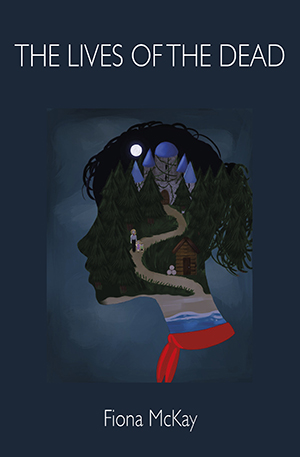
Reviewed by Emily Webber
Fiona McKay’s novella-in-flash, The Lives of the Dead [Ad Hoc Fiction, 2025] draws us into Kate’s life as she stands on the brink of marriage and motherhood. Reading this collection feels like walking down a familiar path, but perhaps you’ve always done it during the day, and now you’re experiencing it at night. Your feet know where to go, but there’s also something unsettling and strange. You feel safe enough and believe you’ll make it home, but you might not be exactly the same afterwards, just like Kate.
The breeze pushes through her, meets no resistance in the meat of her body, in her bones that clank along, shifting and re-forming their shapes and angles. Ligaments are loose, but tightening. She will be herself again. Maybe. A version, anyway. (47)
You’ve heard these stories before. They contain familiar themes and images, but McKay makes them new, including rewriting fairy tales such as Rapunzel and Cinderella alongside Kate’s story. Through these dual narratives, she shows us how a woman can become trapped by the sacrifices she’s asked to make for her husband and children.
If you pay close attention to the beginning of this novella and notice the clues that McKay weaves in, you’ll realize that these milestones and Kate’s life aren’t going to turn out the way she hoped. In the opening story, Kate meets her boyfriend John’s mother for the first time. John orders for her before she even arrives, telling her she doesn’t need coffee late in the day. When she says she wants coffee, it never comes. Then, more alarmingly, Kate calls attention to the tiny bruises on her wrist, saying she doesn’t know how she got them. John’s mother jokes that you always know the princesses by how they bruise so easily, a chastisement to Kate that she’s too sensitive. What follows is a loss of everything Kate loves—her job teaching French, nights out at bars, travel, then her voice in all decisions. McKay emphasizes Kate’s feelings through a fairy tale:
And so, the young woman stays. She and the prince marry, are blessed with children, rule the kingdom benignly and are loved by their people. The old queen keeps the heart safe, locked away, from time to time carving off some gold, selling off another jewel, and each time she does so, the young woman feels a sharp pain in her empty chest. But she stays – she has no choice – and all the while, the heart is shrinking, shrinking, shrinking. (10)
Kate’s husband, John, might seem like a perfectly fine man on the surface according to society’s standards. He has a great job, so she stays home with the kids. He adores his children—playing with them, bathing them, and taking them out. As Kate struggles with the expectation that a woman should be grateful for such a man, we are taught alongside her. But McKay makes Kate and the reader question a man who holds a woman’s wrist so tightly he leaves bruises, gaslights her into thinking she agreed to certain things, or ignores her misery and depression. Otherwise, society tells us, he’s fine.
The structure of The Lives of the Dead, which includes flash fiction pieces centered on Kate, mixed with pages of her internet searches and the fairy tale retellings, creates a feeling of timelessness. The fairy tales are somewhat familiar but rewritten to mirror Kate’s world, where the familiar warps and distresses instead of providing comfort.
Spirits flit, and for those observing closely, there is an afterburn, a ghostly echo of where they have been. A vindictive gust of wind that rips through the trees, lifts up the carpet of soil, roots, moss, exposing the tender flesh of the earth beneath. (18)
The fairy tale retellings remind us that, since the beginning of time, stories exist where women are losing control to men, suppressing their own desires, and living in isolation. McKay creates tension in Kate’s ability to overcome such tales or further sink into despair and loneliness.
Is it possible to take control away from a man who controls everything?
McKay provides insight into what can elicit change. For all the magical elements of the fairy tales, Kate finds answers in practical life, like finding a community of women, working towards financial independence, and prioritizing self-worth, even if it means her relationship will not survive.
There are always sounds in the forest. Rustlings. Twigs snapping. She wears her hood up, covering her head, covering the freezing tips of her ears. It’s hard to make out the sounds, how to assess the level of threat. Every time she makes it safely to the cottage, it feels like victory. (93)
In The Lives of the Dead, the danger never fully goes away, but there’s a hard-won shift for its protagonist. Even if Kate must ultimately sacrifice her marriage, McKay creates the possibility of another kind of happily ever after.
Purchase The Lives of the Dead through Ad Hoc Fiction, available now.
___________________________
 Emily Webber is a reader of all the things hiding out in South Florida with her husband and son. A writer of criticism, fiction, and nonfiction, her work has appeared in the Ploughshares Blog, The Writer, Five Points, The Rumpus, Necessary Fiction, and elsewhere. She’s the author of a chapbook of flash fiction, Macerated. Read more at emilyannwebber.com
Emily Webber is a reader of all the things hiding out in South Florida with her husband and son. A writer of criticism, fiction, and nonfiction, her work has appeared in the Ploughshares Blog, The Writer, Five Points, The Rumpus, Necessary Fiction, and elsewhere. She’s the author of a chapbook of flash fiction, Macerated. Read more at emilyannwebber.com

 The SmokeLong Grand Micro Contest (The Mikey) is now an annual competition celebrating and compensating the best micro fiction and nonfiction online.
The SmokeLong Grand Micro Contest (The Mikey) is now an annual competition celebrating and compensating the best micro fiction and nonfiction online.